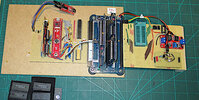Would be good to see what other projects members are ' playing ' with
I have a couple of 70s recreation projects on the go:
A rebuild of my very first working computer, using the original (or original type) main ICs, but with modern RAM and a GAL for address and control decode rather than dozens of TTL ICs; the original used 4 - 5 board in a rack, mostly for all the decode and timing etc.
This also eliminates all the bus driver/receiver ICs, as with so few devices on the data bus, they can all connect directly.
The only parts I was short of for this were the 14536 timer, used for the oddball bit-banged serial interface needed by the MIKBUG ROM, and the 6875 clock generator - which arrived in the post just now as I was going to take a photo, so that's now in the parts box!
It's a bit of an upgrade from the original - that started out with 256 Bytes RAM and maxed out at 4K; this has 32K and an extra 2K for the MIKBUG scratchpad area - it only needs 128 bytes but the 6116 is cheaper than a pair of 2101's
I still have to add a MAX232 & socket for the RS232 interface.
The other one is a much more complicated system, functionally like my second computer using a 6809 and running OS/9
This is still a multi-card rack system due to its complexity, even though it's now using modern RAM and GALs; the boards are CPU and RAM, Serial I/O and RTC (required for the OS), and a Floppy disc interface.
That is complex in itself, as it uses DMA to an onboard RAM.
I have all my original drawings, though converting from masses of TTL gates etc. to GALs is taking some time so still testing through this.
It has 1M RAM, the same as the original ended up with - though that was a separate board full of dynamic RAM ICs, whereas now it's just the two 32 pin ones on the CPU board.
I had to get rid of the original machines decades ago due to space and moving around in the early 80s (bedsit etc) but saved the important ICs, EPROMS and discs etc.

![IMG_0969[1].JPG IMG_0969[1].JPG](https://www.electro-tech-online.com/attachments/img_0969-1-jpg.139460/)


